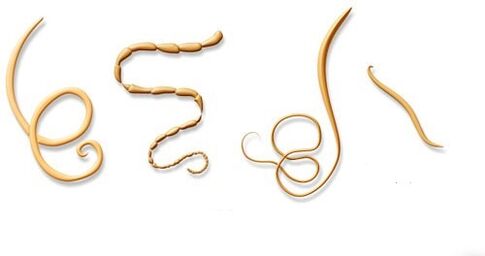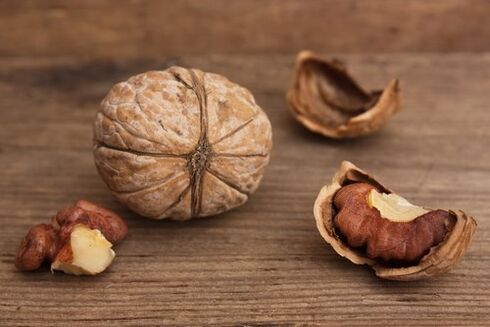Parasites are the simplest living organisms in humans. For nutrition, they use cells, vitamins, nutrients, tissues - all of which are beneficial to our health.
In addition, parasites are known to poison the body by releasing harmful substances. Let us look in more detail at the symptoms of the presence of parasites in the human body, its habitat, how to get rid of it and preventive measures against its appearance.
Danger of parasites in the body
First of all, the working capacity of the organ is disturbed, that is, inflammation occurs which damages the tissue. Often these creatures are foreign to us producing toxins, which over time contribute to the poisoning of the whole organism.

Microorganisms that live in the gut eat nutrients that enter the stomach along with food. As a result, the first symptoms of the presence of parasites in the body arise: a person experiences slow growth, as well as a violation of mental and physical development.
Parasites have the ability to live for many years, and eggs with larvae are highly resistant to the surrounding microflora.For example, in the digestive system, for their own defense, they release substances that paralyze enzymes that process food during metabolism.
After that, the digestive process is disrupted. Therefore, sometimes the symptoms of the presence of parasites in the human body often resemble gastrointestinal diseases.
Common parasites
The most common human parasites are as follows:
- lice- these arthropod bites first irritate the skin, and then turn into eczema or purulent lesions;
- cream worms- small round worms with white color, causing diseases such as enterobiasis;
- ringwormis a parasitic worm, whose vital activity occurs in the intestinal tract. The length of individual sexual maturity of men reaches 24 cm, females 40 cm;
- whip- ranks 3rd in terms of frequency of the disease. Infection with this parasite causes the disease - trichocephalosis. Females from this parasite are large, reaching 5. 5 cm, males are slightly smaller - from 4 to 5 cm;
- Giardia- lives in two formations: vegetative forms and spores. In the first case, their vital activity takes place in the upper part of the small intestine, in the second - in the large intestine;
- cat fluke- affects the liver and provokes the occurrence of opisthorchiasis;
- Trichinella- round worm. Causes helminthic invasion;
- toxocara- similar to ringworm, only larval diameter is 0. 02 mm;
- intestinal acne- filament parasites up to 2 mm;
- nekator- toothed worm larvae enter the body through the pores during walking barefoot. Their pathway begins with the right atrium and ends with the pulmonary artery. Breaking the capillary wall, they enter the alveoli and from there through the airways to the pharynx.

Path of infection
You can be infected in many ways. Each relates to a specific parasitic expansion cycle. However, in the medical field, there are 3 main sources of infection:
- Through food and water.However, pollution often occurs due to improper storage and preparation. But sometimes there is an early infection, i. e. when the parasite-infected product has undergone poor heat treatment;
- Through the method of household relations.In this case, the infection is transmitted from another person or pet;
- Through blood-sucking insects.This route is also known as transmission;
- Through communication with pets,who walk the streets.

There are larvae that are able to enter the human body freely. Symptoms of the presence of parasites of this form are dermatobiasis. In this case, the larvae hit the skin, gnawing on themselves and ending up inside the host body.
Signs of parasitic presence
We suggest considering 10 key features:
- Constipation.Obstruction of the organs of the digestive system can occur because the large size of the worm interferes with the normal course of peristalsis or secretion. Many close the ducts (bile and intestines), thus complicating the process of bowel movements.
- Diarrhea.There are parasitic living organisms that produce hormone-like substances that cause watery bowel movements.
- Flatulence, gasis another factor in the presence of worms. If you do not notice periodic bloating, then the symptoms of the presence of parasites will appear in the human body with varying intensity and for several months, and sometimes years.
- Irritable bowel syndrome.Parasites can not only irritate, but also cause inflammation. As a result, this causes a decrease in the rate of assimilation of the substance.
- Pain in muscle tissue and joints.To find the most comfortable environment, some microorganisms move in the body. More often they choose muscle or joint fluid. Therefore, a person experiences pain and often associates these symptoms with the effects of arthritis. Also, these symptoms are thought to be the result of injury to the muscle tissue worms.
- Allergies.Toxins often increase the dose of eosinophil production. It is this substance that irritates tissues and causes allergies.
- Skin problems.Often, worms cause rashes, eczema, urticaria. Their presence also results in skin ulcers, dermatitis, swelling and papilloma. When the gastrointestinal tract is infected, the face is covered with initial wrinkles, baldness appears, visible cracks in the heel, and nails become brittle.
- Anemia.As mentioned earlier, parasites absorb all nutrients, and large amounts cause blood loss. As a result, the body is deficient in iron.
- Overweight.This symptom is associated with the defeat of the body by tapeworms, this means one thing: the protective reaction of the human body due to poisoning with products that contribute to the vital activity of parasites.
- Nervousness.Toxins produced by microorganisms irritate the central nervous system. As a result, a person experiences depression, increased anxiety and restlessness.


Watch out! Diarrhea and constipation are not only due to malnutrition, but also the first symptoms of the presence of parasites in the human body.
How to identify by appearance
According to their place of vital activity, parasites are divided into 2 types:
- Endoparasites(worms, lamblia, echinococcus, etc. ) - those that live inside;
- Ectoparasites,live outside (lice, fleas, fleas).
Ectoparasitic lice can be easily identified by appearance. The rash appears on the body, accompanied by itching, redness, and burning sensation. Often a small wound (penetration site) remains at the site of the bite.

Determining endoparasitic attacks is more difficult, as they live in the body. These parasites have learned to adapt to the host body during evolution. Studies show that it sometimes takes months, or even decades, from the moment of infection to the onset of primary symptoms.
How to diagnose the disease
The diagnosis of aggression may occur with the following symptoms:
- pale skin;
- gastrointestinal problems;
- lesions of the upper layer of the dermis;
- cosmetic problems;
- weight gain;
- occurrence of chronic fatigue syndrome;
- common headaches;
- grind teeth during sleep;
- swollen limbs;
- pain in joints and muscles;
- central nervous system disorders;
- itching in the perineum and anus.
Is treatment always needed
When infected, the human body becomes weak, allergic, and poisoned. Of course, the rapid development of these symptoms is not observed, but lack of treatment often leads to serious health problems.
Drugs from pharmacies
The most effective drugs include the following drugs:
- for ascariasis: piperazine adipate and pyrantel;
- for enterobiasis: mebendazole;
- from paragonimiasis, schistosomiasis, opisthorchiasis,
- for echinococcus: mebendazole;
- from the tapeworm: praziquantel.
Popular folk remedies
In addition to garlic seeds and white pumpkin seeds, as the three most useful products to withstand parasitic attacks, nature has created 3 plants that can cleanse the human body when the first symptoms of parasitic attacks appear: cloves, walnuts and wormwood.
Cleanses the body of enterobion with walnuts.Pour 0. 5 liters of vodka into a 15 walnut green crust and place in a dark place for a month. Take in 5 days, after dissolving one drop of tincture in 0. 1 l of water. After that, increase the dose to 2 -2, 5 tsp. and take 2 times a day for a year.

Purification with medicinal plant worm medicine.Grind the seeds of dried plants. Reception should begin with one pinch. By the 15th day of admission, the dose should reach 1. 5 hours. After that, take 0, 5 teaspoons a day. Finally, use the same dose only once a week.
Cleanses the body with cloves.Grind the seeds into a powder. You should start with 1. 5 teaspoons, gradually reducing the dose to one tablespoon. The admission course is 10 days.
Prevention of infection
Once a parasite enters our body, it passes through 3 environments:
- Alkaline (oral cavity);
- Sour (stomach);
- Alkaline (bile).
If everything fits every barrier, then you will not be afraid of a single parasite. Even though it is already in the body, it will be released naturally. But when at least one obstacle is breached, this indicates a breach of the entire system.
First,to prevent infection, it is necessary to maintain good hygiene of the hands and the whole body, tidying the oral cavity: healing sore teeth, bleeding gums, stomatitis, getting rid of unpleasant odors.

Second, make a drinking regimeand follow a proper diet.
Third, eliminate bile stagnation.
And, of course, for the prevention of parasitic diseases, do not forget about the general rules of hygiene.






































